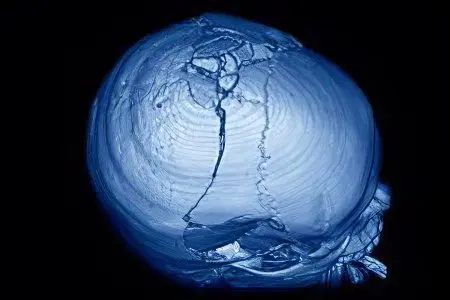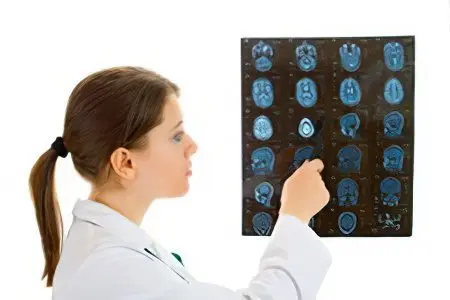Contents

Fractures of the calvarium are divided into several types:
Depressed, in which a broken bone is pressed into the skull. The consequence of this may be damage to the dura mater, vessels and medulla, the formation of extensive hematomas;
Comminuted, in which the bone breaks up into several fragments that damage the structures of the brain, and the same consequences appear as with a depressed fracture;
Linear, the least dangerous, in which damage to the cranial bone looks like a thin crack.
With a linear fracture, there is no displacement of the bone plate or it is no more than 1 cm. Bones with this type of fracture can grow together without serious complications and consequences. However, it is possible to form epidural (between the inner surface of the bone and the meninges) hematomas due to internal hemorrhage, which increase gradually and make themselves felt only 1,5-2 weeks after the injury, when the victim is already in a rather serious condition.
In most cases, the parietal bone is damaged, sometimes the frontal and occipital are captured. If the fracture line crosses the lines of the cranial sutures, this indicates a significant force on the head and a high probability of damage to the dura mater. In this regard, such a type of linear fracture is distinguished as diastatic (“gaping”), which is characterized by the transition of the fracture line to one of the cranial sutures (most often found in young children).
Causes of a linear fracture of the skull
Such a fracture, as a rule, appears as a result of an impact with an object with a large area. Usually there are traces of mechanical impact (abrasion, edema) over the fracture site.
Skull fractures can be: direct, indirect. With a direct impact, the bone is deformed directly at the site of impact, with an indirect impact, the impact is transmitted from other damaged bones. Unlike fractures of the base of the skull, fractures of the vault in most cases are straight.
Symptoms of a linear fracture of the skull
A wound or hematoma is found on the scalp, while there is no depression of the bones felt on palpation.
Common signs of any fracture include:
Severe headaches;
Nausea, vomiting;
Lack of pupillary response;
Respiratory and circulatory disorders in case of compression of the brain stem;
Confusion or loss of consciousness.
Diagnosis of a linear fracture of the skull

To make a diagnosis, the method of craniography is used (X-ray examination of the skull without the use of a contrast agent). In some cases, cracks may extend through several bones. When examining images, special attention should be paid to the intersection of the vascular furrows with a fissure, since this may damage the intracranial vessels and meningeal arteries, which causes the formation of epidural hematomas. Sometimes the edges of the hematoma can be compacted and raised, which creates the impression of a depressed fracture on palpation.
Sometimes in medical practice there are errors when the shadow of the vascular sulcus is taken for an incomplete fracture (crack). Therefore, it is necessary to take into account the location of the arterial grooves and the specifics of their branching. They always branch in a certain direction, their shadows are not as sharp as the fracture lines.
A linear fracture on an x-ray has the following distinguishing features:
Fracture line in black;
The fracture line is straight, narrow, without branching;
The vascular sulcus is gray in color, wider than the fracture line, tortuous, with branching;
The cranial sutures are gray in color and of considerable width, with a standard course.
8-10 days after TBI, fractures in the bones are more clearly defined than immediately after the injury.
Treatment of a linear fracture of the skull
In the absence of intracranial hematomas and damage to brain structures, linear fractures do not require surgical intervention and require only supportive therapy, which includes wound treatment and the use of mild painkillers. In case of loss of consciousness, the victim is observed in a medical facility for at least 4 hours. If, as a result of an examination by a neurosurgeon, it is found that vital functions are not impaired, the patient can be released under home observation.
Within a few weeks after the injury, the area of the fracture is filled with fibrous tissue. If the fracture line is narrow enough, then its ossification occurs in the future. The ossification process lasts approximately 3-4 months in children and up to 2-3 years in adults. If the width of the crack exceeds a few millimeters, then bone bridges form in the fibrous tissue that fills it.
Conservative treatment is also subject to cracks in the cranial vault, which continue to its base, but do not pass through the walls of the nasal airways, pyramids and cells of the mastoid processes.
The indication for surgical intervention is the displacement of the bone plate, as a result of which it protrudes above the surface of the cranial vault by more than 1 centimeter. In this case, there is a high risk of damage to the meninges and other brain tissues, which can lead in the future to such long-term consequences as epilepsy.
If this fracture occurred in a child under the age of three years and was accompanied by a rupture of the dura mater, then in the future the edges of the fracture line may diverge wider and a linear defect of the skull is formed. The arachnoid membrane, filled with cerebrospinal fluid, begins to protrude, and the bones gradually diverge even wider. In this case, plastic surgery is recommended.
In most cases, a linear fracture heals without any special consequences for the victim, but, like any other skull fracture, it can provoke the development of hypertension.









